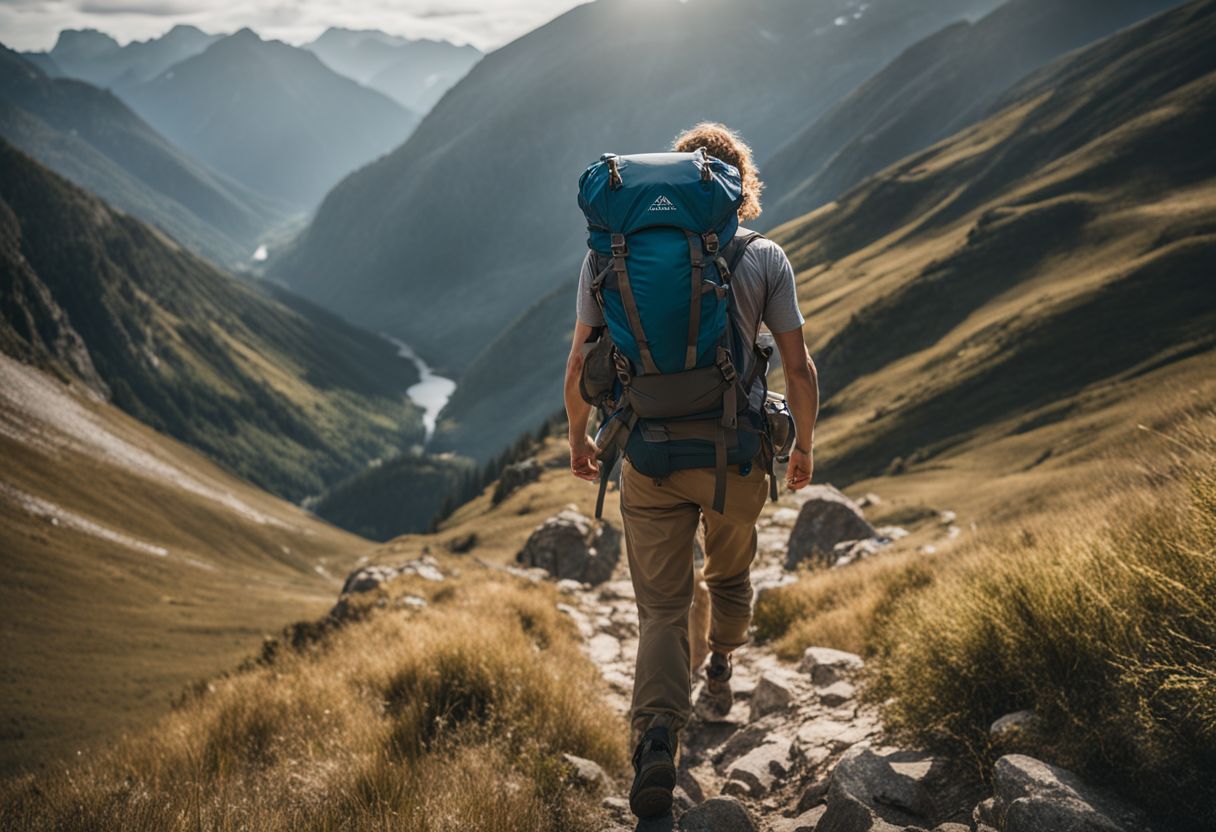Adjusting the straps on your rucksack isn’t just a matter of comfort; it’s a science that safeguards your musculoskeletal health. With years of experience guiding outdoor enthusiasts and backpackers, I’ve learned the critical impact that a properly fitted pack has on overall trekking enjoyment and endurance.
From navigating rugged terrain to strolling through an airport, how you carry your load can mean the difference between adventure and agony.
Fundamental to achieving this balance is understanding weight distribution. A well-fitted backpack centers its load aligned with your body’s center of gravity, reducing strain on sensitive areas like the neck and lumbar region—areas often neglected in standard fitting guides but crucial for long-term spinal health.
This article will share insights drawn from expert knowledge in biomechanics and field-tested techniques to ensure you’re packed right for any journey. Ready for a game-changer? Read on!
Key Takeaways
- Properly fitting your rucksack helps distribute weight evenly, reduces strain on your body, and prevents discomfort or injury during hiking.
- Choosing a rucksack that matches your body type is crucial for optimal comfort and support. Consider torso length, hip size, and adjust the shoulder straps, chest strap, load lifters to ensure a comfortable fit.
- Adjusting the rucksack while walking ensures good weight distribution and balance. Regularly check and readjust the fit to avoid back pain or injuries in the long run.
Why Properly Fitting Your Rucksack is Important

After learning what a rucksack is, it’s key to know why fitting it right matters. A well-fitted rucksack makes sure the weight inside does not hurt your back or shoulders. It spreads the load evenly across your body.
This means you can carry your gear longer without getting tired or sore.
A snug fit helps keep you balanced on hikes or trips. Your hips should take on most of the weight, not your shoulders. With straps at just the right tightness, you can move freely and stay safe from falls or stumbles.
Your spine stays in line too. Making sure your backpack fits isn’t just about comfort; it’s about taking care of yourself while on an adventure.
Choosing the Right Rucksack for Your Body Type

Getting the right fit is more than just adjusting straps; it starts with picking a rucksack that matches your body. Your torso length and hip size are key to finding a backpack that won’t hurt you.
Look for bags with different sizes, like small, medium, or large, which relate to your torso measurement. Some packs even let you move the shoulder harness up or down to fit better.
You must also think about your waist belt sitting on the iliac crest – that’s the top part of your hips. The hipbelt should wrap firmly here because it carries most of the backpack’s weight.
Don’t forget to check if the sternum strap can slide up or down so it sits across your collarbone comfortably without pressing into your neck.
Your bag needs to hold all your stuff but still fit snugly against your back. If you do snowboarding or other sports, make sure there’s room for extra gear too. And always try on a few different styles with some weight inside to see what feels best while moving around before making the final choice.
How to Adjust Your Rucksack Straps for Optimal Fit
Loosen all straps and load your pack, then fasten the hipbelt at hip level to distribute weight efficiently. Adjust the shoulder straps, chest strap, and load lifters for a comfortable fit that minimizes strain on your back and shoulders.
Tighten compression straps to secure the load in place. Read more about achieving optimal rucksack fit for a comfortable hiking experience.
Loosen all straps and load your pack
Getting the right fit for your rucksack starts with setting up your pack properly. First, make sure every strap is loose before you put anything inside.
- Find a flat surface to place your backpack on and open all of its compartments.
- Take out all straps, including the ones for your shoulders, hips, and chest.
- Make each strap as long as it can go. This means loosening them until they can’t get any looser.
- Now, start filling up your backpack with your hiking gear. Think about what items you need to reach quickly and put those on top or in easy-to-reach pockets.
- Place heavier things close to your back to keep the weight near your core. This helps with balance.
- Once loaded, lift your backpack onto your back gently.
Fasten the hipbelt at hip level
Once you have loosened all the straps and loaded your pack, the next step is to fasten the hipbelt at hip level. This is crucial for distributing weight effectively onto your hips and off your shoulders.
- Place the hipbelt around your waist, positioning it on top of your hip bones.
- Secure the buckle and adjust the strap so that it is snug and secure without pinching your hips.
- Ensure that the belt is level and centered on your body to transfer weight effectively.
Adjust the shoulder straps
Once you have fastened the hipbelt at hip level, the next step is to adjust the shoulder straps for a comfortable fit. Here’s how to do it:
- Pull the shoulder straps snug against your shoulders.
- Make sure the straps are not too tight or too loose, allowing for easy arm movement.
- Ensure that the weight of the pack is evenly distributed on both shoulders.
- The top of the shoulder straps should sit about 2 inches below the top of your shoulders.
Adjust the chest strap
To ensure proper fit and support, adjusting the chest strap on your rucksack is crucial. Here’s how to do it:
- Position the chest strap across your chest, between your pectoral muscles.
- Pull the strap snugly but not too tight, allowing for comfortable breathing and movement.
Tighten the load lifters
After adjusting the chest strap, the next step is to focus on tightening the load lifters. This ensures that your rucksack fits snugly and comfortably.
- Locate the load lifters near the top of your shoulder straps.
- Pull them gently upward and backward to take some weight off your shoulders.
- Adjust them until they form a 45 – degree angle with the main body of the pack and feel comfortable on your shoulders.
Tighten the compression straps
After adjusting the shoulder straps and hipbelt, the next step in achieving optimal rucksack fit is to tighten the compression straps. These straps are typically located on the sides of the rucksack, and their purpose is to hug the load close to your back. Here’s how to adjust them:
- Locate the compression straps on both sides of your rucksack.
- Pull each strap firmly to tighten it, ensuring that the load is snug against your back.
- Make sure that both sides are equally tightened to maintain balance and stability.
- Check for any excess slack in the straps and readjust as needed for a secure fit.
- Properly tightened compression straps help distribute weight evenly and prevent it from shifting during movement, reducing strain on your body.
Tips for Adjusting Your Rucksack While on the Move
Adjusting your rucksack while walking can save you from discomfort. It’s best to stop before making adjustments to your pack. Always adjust the shoulder straps first, then the hipbelt.
Ensure good weight distribution and balance as you move. Remember that a well-fitted rucksack reduces strain on your body during hiking.
Also, keep the load close to your body for stability and comfort. A properly adjusted chest strap helps distribute weight evenly. Regularly checking and readjusting the fit of your rucksack as you walk is crucial for avoiding back pain or injuries in the long run.
Conclusion
In conclusion, properly fitting your rucksack is essential for comfort and injury prevention. The strategies provided are practical, easy to implement, and efficient. Have you considered how these adjustments can improve your hiking experience? By ensuring a perfect fit, you can prevent discomfort and enhance your outdoor adventures.
Remember that the impact of these strategies leads to significant improvements in long-term use and comfort. Now go ahead, make those adjustments, and enjoy the benefits on your next outdoor journey!
FAQs
1. How do I adjust my backpack straps the right way?
To adjust your backpack straps correctly, start by making the shoulder belts tight enough so that the top of your backpack is just below your C7 vertebrae, which you can feel at the base of your neck.
2. Why is it important to fit my rucksack properly?
Fitting your rucksack well means it won’t hurt your back or shoulders. It should sit on your cervical spine comfortably without pressing too hard on any one spot.
3. Can adjusting my rucksack straps help avoid pain around my rib cage?
Yes! If you tighten and position the straps so they let some weight rest on your hips instead of all on your shoulders, it can stop the bag from squeezing against your rib cage.
4. Should I share how I fix my bag’s fit online with others?
Sure! Telling friends or people on social media about how to get a good trade-off between comfort and support when fitting their bags might really help them out.

